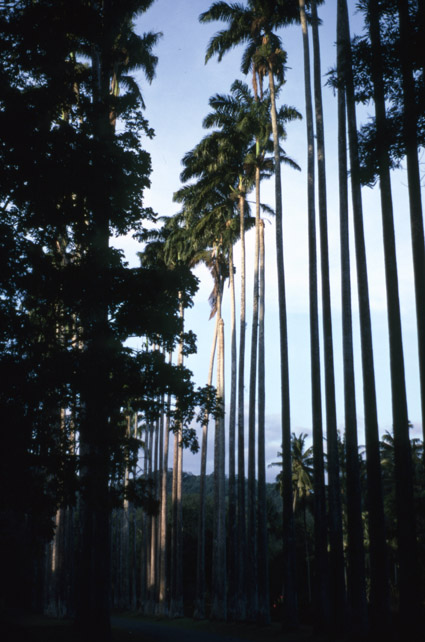- Acanthophoenix
- Acrocomia
- Actinokentia
- Actinorhytis
- Adonidia
- Aiphanes
- Allagoptera
- Ammandra
- Aphandra
- Archontophoenix
- Areca
- Arenga
- Asterogyne
- Astrocaryum
- Attalea
- Bactris
- Balaka
- Barcella
- Basselinia
- Beccariophoenix
- Bismarckia
- Borassodendron
- Borassus
- Brassiophoenix
- Burretiokentia
- Butia
- Calamus
- Calyptrocalyx
- Calyptrogyne
- Calyptronoma
- Carpentaria
- Carpoxylon
- Caryota
- Ceratolobus
- Ceroxylon
- Chamaedorea
- Chamaerops
- Chambeyronia
- Chelyocarpus
- Chuniophoenix
- Clinosperma
- Coccothrinax
- Cocos
- Corypha
- Cryosophila
- Cyphokentia
- Cyphophoenix
- Cyphosperma
- Daemonorops
- Deckenia
- Desmoncus
- Dictyocaryum
- Drymophloeus
- Dypsis
- Elaeis
- Eleiodoxa
- Eremospatha
- Eugeissona
- Euterpe
- Gaussia
- Geonoma
- Guihaia
- Hedyscepe
- Hemithrinax
- Howea
- Hyophorbe
- Hyospathe
- Hyphaene
- Iriartea
- Iriartella
- Itaya
- Jailoloa
- Johannesteijsmannia
- Juania
- Jubaea
- Jubaeopsis
- Kentiopsis
- Kerriodoxa
- Korthalsia
- Laccospadix
- Laccosperma
- Lanonia
- Latania
- Lemurophoenix
- Leopoldinia
- Lepidocaryum
- Lepidorrhachis
- Leucothrinax
- Licuala
- Linospadix
- Livistona
- Lodoicea
- Lytocaryum
- Manicaria
- Manjekia
- Marojejya
- Masoala
- Mauritia
- Mauritiella
- Maxburretia
- Medemia
- Metroxylon
- Myrialepis
- Nannorrhops
- Nenga
- Neonicholsonia
- Neoveitchia
- Nephrosperma
- Normanbya
- Nypa
- Oenocarpus
- Oncocalamus
- Oncosperma
- Orania
- Oraniopsis
- Parajubaea
- Pelagodoxa
- Phoenicophorium
- Phoenix
- Pholidocarpus
- Pholidostachys
- Physokentia
- Phytelephas
- Pigafetta
- Pinanga
- Plectocomia
- Plectocomiopsis
- Podococcus
- Pogonotium
- Ponapea
- Prestoea
- Pseudophoenix
- Ptychococcus
- Ptychosperma
- Raphia
- Ravenea
- Reinhardtia
- Retispatha
- Rhapidophyllum
- Rhapis
- Rhopalostylis
- Roscheria
- Sabal
- Sabinaria
- Salacca
- Saribus
- Satakentia
- Satranala
- Schippia
- Sclerosperma
- Socratea
- Solfia
- Sommieria
- Syagrus
- Synechanthus
- Tahina
- Tectiphiala
- Thrinax
- Trachycarpus
- Trithrinax
- Veitchia
- Verschaffeltia
- Voanioala
- Wallaceodoxa
- Wallichia
- Welfia
- Wendlandiella
- Wettinia
- Wodyetia
- Zombia
- x Jubautia splendens
- ?? Acoelorrhaphe
- ?? Bentinckia
- ?? Brahea
- ?? Clinostigma
- ?? Colpothrinax
- ?? Copernicia
- ?? Cyrtostachys
- ?? Dictyosperma
- ?? Dransfieldia
- ?? Heterospathe
- ?? Hydriastele
- ?? Iguanura
- ?? Incertae sedis & excluded names
- ?? Loxococcus
- ?? Micronoma
- ?? Paripon
- ?? Pritchardia
- ?? Rhopaloblaste
- ?? Serenoa
- ?? Washingtonia

Distribution
Lesser Antilles, Barbados, Trinidad and Tobago, northern Venezuela, and northeastern Colombia. Naturalized in Guyana. Surinam, and French Guiana. (Zona, S. 1996. Roystonea.(Arecaceae: Arecoideae). Flora Neotropica Monograph 71, 1-35.)A
Discussion
- Contrary to reports in the literature (Bailey, 1935, 1949; McCurrach, 1960; Tomlinson, 1961), the leaf segments of R. oleracea are not arrayed in a single plane or "series." The segments are arrayed in two planes on either side of the rachis.
The leaves of the crown typically do not hang much below the horizontal, unlike other species in which the leaves droop and obscure the crownshaft. This characteristic allows one to identify palms of this species from a distance. Roystonea oleracea is also noteworthy for its unopened peduncular bract which is strongly clavate with an acuminate tip. Groups of rachillae are undulate, forming wavy curves with amplitudes of 4 cm or more (Zona, S. 1996. Roystonea.(Arecaceae: Arecoideae). Flora Neotropica Monograph 71, 1-35.)A
Description
- Trunk gray, to 40 m tall , 46-66 cm diam.
Leaves 20-22, lowest leaves held at or above horizontal; crowns haft ca. 2 m long; petiole 60-100 cm long, rachis 4-4.6 m long; middle segments 65-94 cm longand 3-4.9 cm wide.
Inflorescence ca. 1.4 m long and 0.7 m wide; prophyll 46.5-53 cm long and 8.8-16 cm wide; peduncular bract ca. 1.5 m long, widest above 23 the middle, apex caudate; rachillae 16-30 cm long and 1.5-2.8 mm diam. Staminate flowers white; sepals triangular, 1.4-1.7 mm long and 1.6-2.6 mm wide; petals elliptical to ovate, 3-4.8 mm long and 1.4-2.7 mm wide; stamens 6-8, 4.4-8.8 mm long; filaments awl-shaped, 3-6.9 mm long; anthers 3.5-4.7 mm long, apices recurved; pistillode minute. Pistillate flowers white, 2.5-4.5 per cm; sepals reniform, 1.5-1.8 mm long and 3.3-4.3 mm wide; petals ovate, 2.6-3.4 mm long; staminode 6-lobed, 1.8-2.5 mm long, free for 0.9-1.2 mm; gynoecium 1.8-2.9 mm long and 1.6-2.5 mm diam.
Fruit ellipsoid, gibbous, 12.6-17.6 mm long, 8.2-10.8 mm dorsiventral thickness, and 7.6-10.4 mm wide; epicarp purplish black, stigmatic scar plain; endocarp ellipsoid, 9.8-13.7 mm long, 6.8-7.7 mm dorsiventral thickness, and 6.8-7.7 mm wide; seed ellipsoid, 7.5-10.5 mm long, 4.6-6.1 mm dorsiventral thickness, and 5.1-6.8 mm wide; raphe circular. Eophyll linear-elliptical, short- or exstipitate, weakly costate. (Zona, S. 1996. Roystonea.(Arecaceae: Arecoideae). Flora Neotropica Monograph 71, 1-35.)A
Use Record
- Roystonea oleracea (Jacq.) O.F.Cook: Arco hecho de madera de chonta, de 156 cm. De largo con madera de una sola pieza. (…). Arpones grandes de 3.2 de largo, hechos de madera de chonta; para el paiche se usa una punta de 12 cm. Con 2 púas. (…). Arpón de flecha (…).(…). El soporte de la punta es de madera de chonta, que se inserta en el huevo contral de la flecha y luego se amarra. (…). (…). El hilado (algodón) se hace con el huso. Los hombres shipibo tallan el uso en madera de palmera de chonta, (…). (Bergman, R. 1980: Economia Amazonica)
Use Category Use Sub Category Plant Part Human Group Ethnic Group Country Utensils and Tools Hunting and fishing Stem Indigenous Shipibo-Conibo Peru Utensils and Tools Domestic Stem Indigenous Shipibo-Conibo Peru - Roystonea oleracea (Jacq.) O.F.Cook: Debido a su gran porte es una palma muy utilizada como ornamental en las ciudades alrededor del mundo. (Gutiérrez-Vásquez, C.A. and R. Peralta 2001: Palmas comunes de Pando, Santa Cruz de la Sierra, Bolivia)
Use Category Use Sub Category Plant Part Human Group Ethnic Group Country Environmental Ornamental Entire plant Not identified N/A Bolivia
- Log in to post comments

